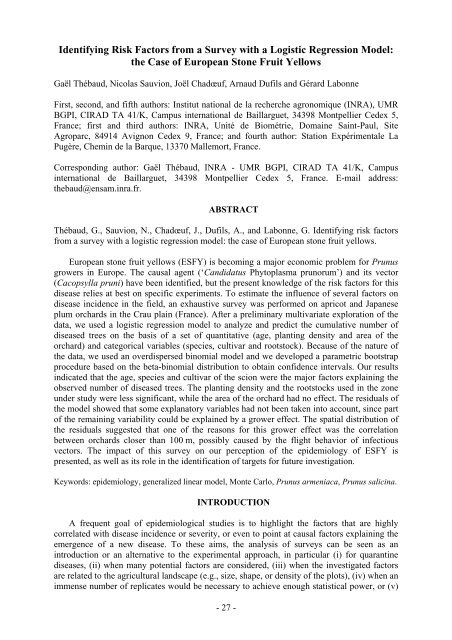Ecole Nationale Supérieure Agronomique de Montpellier ... - CIAM
Ecole Nationale Supérieure Agronomique de Montpellier ... - CIAM
Ecole Nationale Supérieure Agronomique de Montpellier ... - CIAM
You also want an ePaper? Increase the reach of your titles
YUMPU automatically turns print PDFs into web optimized ePapers that Google loves.
I<strong>de</strong>ntifying Risk Factors from a Survey with a Logistic Regression Mo<strong>de</strong>l:<br />
the Case of European Stone Fruit Yellows<br />
Gaël Thébaud, Nicolas Sauvion, Joël Chadœuf, Arnaud Dufils and Gérard Labonne<br />
First, second, and fifth authors: Institut national <strong>de</strong> la recherche agronomique (INRA), UMR<br />
BGPI, CIRAD TA 41/K, Campus international <strong>de</strong> Baillarguet, 34398 <strong>Montpellier</strong> Ce<strong>de</strong>x 5,<br />
France; first and third authors: INRA, Unité <strong>de</strong> Biométrie, Domaine Saint-Paul, Site<br />
Agroparc, 84914 Avignon Ce<strong>de</strong>x 9, France; and fourth author: Station Expérimentale La<br />
Pugère, Chemin <strong>de</strong> la Barque, 13370 Mallemort, France.<br />
Corresponding author: Gaël Thébaud, INRA - UMR BGPI, CIRAD TA 41/K, Campus<br />
international <strong>de</strong> Baillarguet, 34398 <strong>Montpellier</strong> Ce<strong>de</strong>x 5, France. E-mail address:<br />
thebaud@ensam.inra.fr.<br />
ABSTRACT<br />
Thébaud, G., Sauvion, N., Chadœuf, J., Dufils, A., and Labonne, G. I<strong>de</strong>ntifying risk factors<br />
from a survey with a logistic regression mo<strong>de</strong>l: the case of European stone fruit yellows.<br />
European stone fruit yellows (ESFY) is becoming a major economic problem for Prunus<br />
growers in Europe. The causal agent (‘Candidatus Phytoplasma prunorum’) and its vector<br />
(Cacopsylla pruni) have been i<strong>de</strong>ntified, but the present knowledge of the risk factors for this<br />
disease relies at best on specific experiments. To estimate the influence of several factors on<br />
disease inci<strong>de</strong>nce in the field, an exhaustive survey was performed on apricot and Japanese<br />
plum orchards in the Crau plain (France). After a preliminary multivariate exploration of the<br />
data, we used a logistic regression mo<strong>de</strong>l to analyze and predict the cumulative number of<br />
diseased trees on the basis of a set of quantitative (age, planting <strong>de</strong>nsity and area of the<br />
orchard) and categorical variables (species, cultivar and rootstock). Because of the nature of<br />
the data, we used an overdispersed binomial mo<strong>de</strong>l and we <strong>de</strong>veloped a parametric bootstrap<br />
procedure based on the beta-binomial distribution to obtain confi<strong>de</strong>nce intervals. Our results<br />
indicated that the age, species and cultivar of the scion were the major factors explaining the<br />
observed number of diseased trees. The planting <strong>de</strong>nsity and the rootstocks used in the zone<br />
un<strong>de</strong>r study were less significant, while the area of the orchard had no effect. The residuals of<br />
the mo<strong>de</strong>l showed that some explanatory variables had not been taken into account, since part<br />
of the remaining variability could be explained by a grower effect. The spatial distribution of<br />
the residuals suggested that one of the reasons for this grower effect was the correlation<br />
between orchards closer than 100 m, possibly caused by the flight behavior of infectious<br />
vectors. The impact of this survey on our perception of the epi<strong>de</strong>miology of ESFY is<br />
presented, as well as its role in the i<strong>de</strong>ntification of targets for future investigation.<br />
Keywords: epi<strong>de</strong>miology, generalized linear mo<strong>de</strong>l, Monte Carlo, Prunus armeniaca, Prunus salicina.<br />
INTRODUCTION<br />
A frequent goal of epi<strong>de</strong>miological studies is to highlight the factors that are highly<br />
correlated with disease inci<strong>de</strong>nce or severity, or even to point at causal factors explaining the<br />
emergence of a new disease. To these aims, the analysis of surveys can be seen as an<br />
introduction or an alternative to the experimental approach, in particular (i) for quarantine<br />
diseases, (ii) when many potential factors are consi<strong>de</strong>red, (iii) when the investigated factors<br />
are related to the agricultural landscape (e.g., size, shape, or <strong>de</strong>nsity of the plots), (iv) when an<br />
immense number of replicates would be necessary to achieve enough statistical power, or (v)<br />
- 27 -



